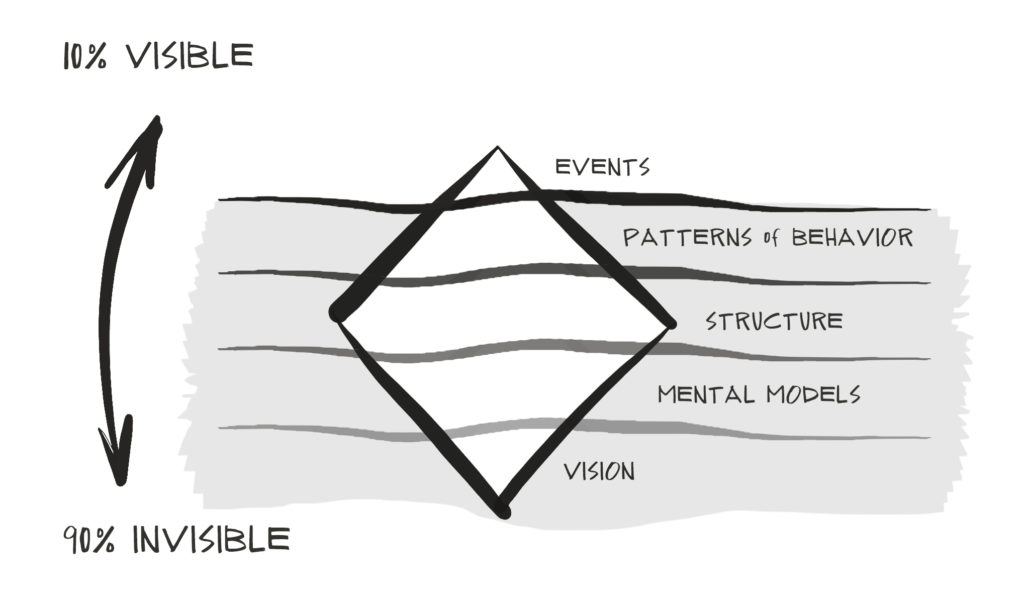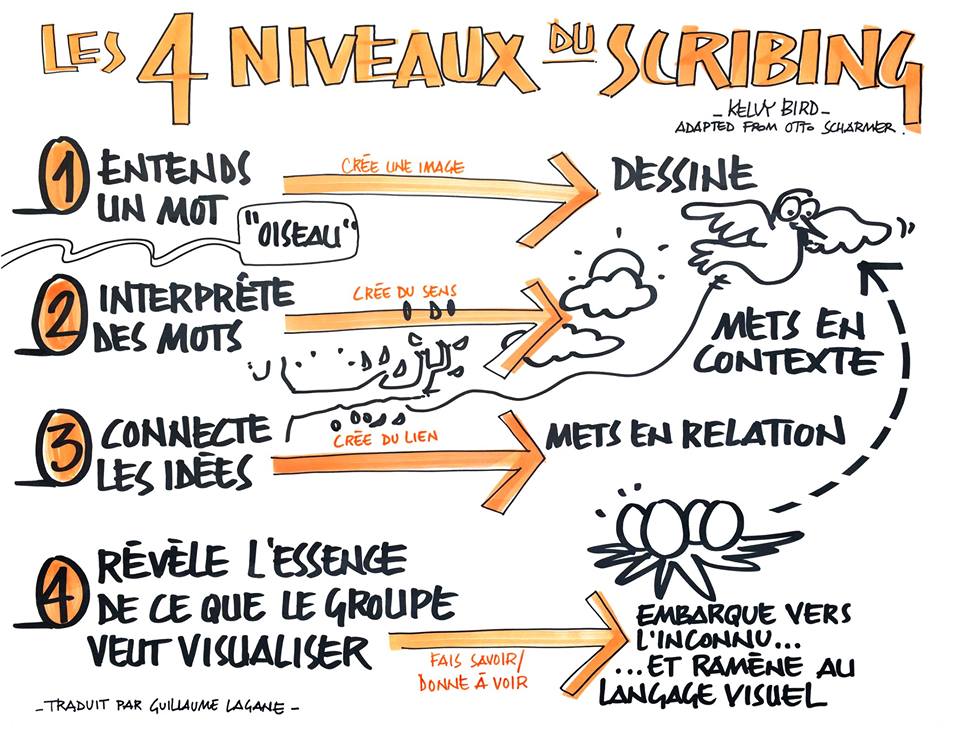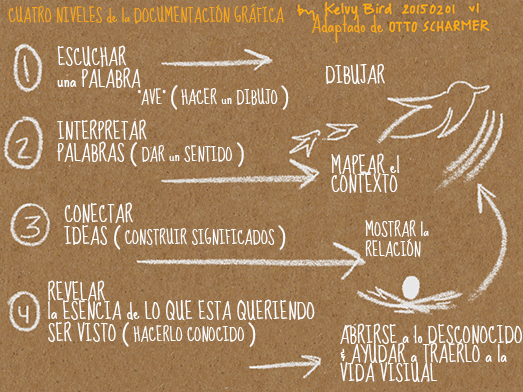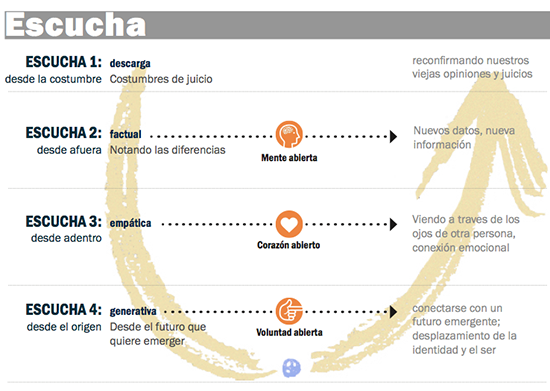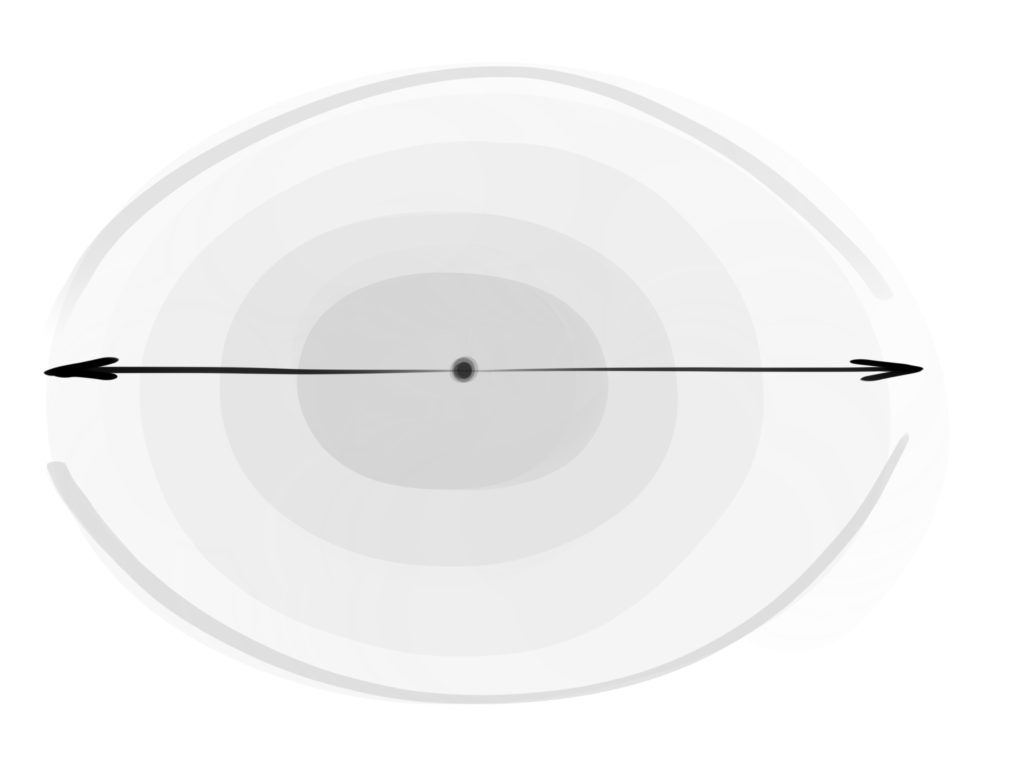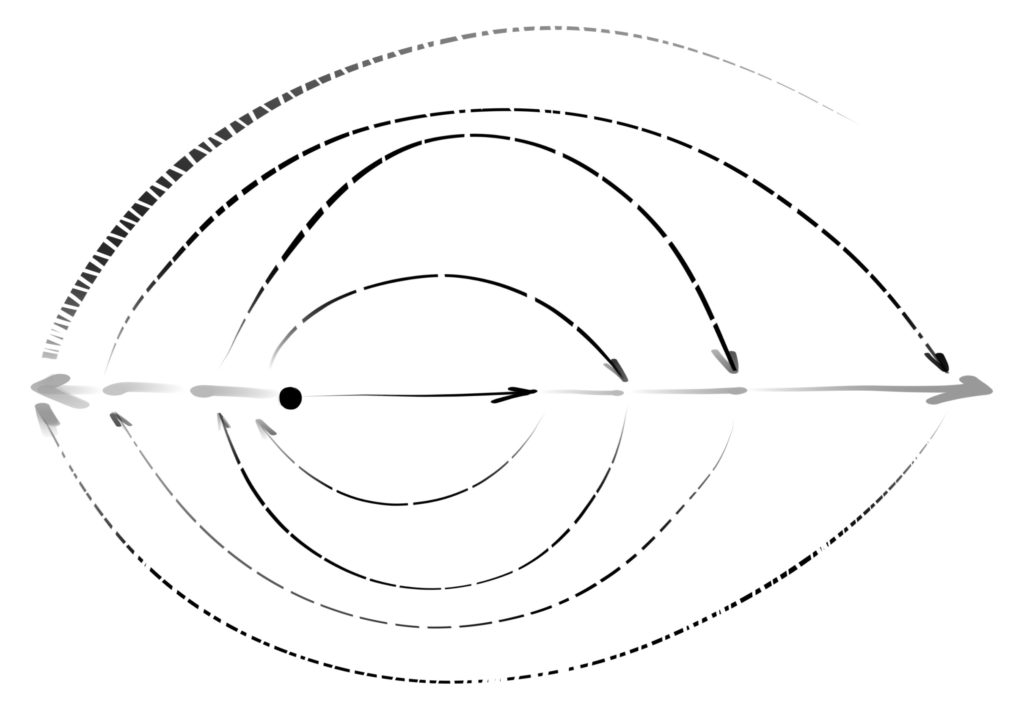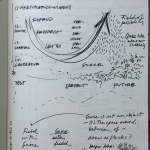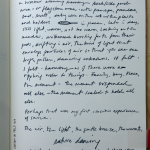The Practice Model for Scribing results from 20 years of collaborative efforts and framework integration, with many dear colleagues along the way. Here is a breakdown. And for a walkthrough of the theory in practice, visit: Decoding a Wall
The Iceberg
The iceberg model, used in systems thinking, is the base note. We are familiar with seeing events, actions, and behaviors – like the exposed tip of an iceberg. But the domain we access internally as facilitators and aim to touch with our graphics is at the level of structure – that less seen, in the domain of patterns and mental models and vision. We seek to find relation between pockets of words and concepts and aspirations to intentionally reveal where there is open loop (linear, sequential, start-to-end) and closed loop (systems, integrated, interrelated) thinking.
In graphic facilitation, this requires venturing beyond the known – the tip of the iceberg – and moving into a realm of trust and sensing, listening internally and within the room to what is wanting to surface. With this in mind, the facilitator has an opportunity to recontextualize what is being said to shift levels of perception and comprehension.
More: Iceberg model
References: Peter Senge, John Sterman, Leanne Grillo, indirectly Daniel Kim
The Diamond
As a scribe, the practices of joining (including listening), knowing, perceiving, and our stance of being ALL function together to ground and orient us in a decision-making process before and while we draw. This framework has tiers of related thinking, including: dialogic principles, Jungian archetypes, ShadowWork, family systems therapy, and The Symbols Way. All speak to the nature of a whole systems approach to change, where the art of the facilitator is to dance between the domains – in ourselves and the way they outwardly manifest – to help an individual or group shift into a possibility.
References: William Isaacs, Peter Garrett, The Ashland Institute, Cliff Barry, David Kantor, indirectly David Bohm
Be
This area at center speaks to the inner stance we hold when showing up: with a person, in a room, at the board or wall. (Referring to Scharmer’s work) We seek to suspend judgment, quiet cynicism, move through fear, so that one can approach the work with an open mind, heart, and will – insuring space to receive what wants to come through into the room. This is the place where Presencing most intersects our practice, at the center of the scribe, at core, and thus as a centering device in the room and system. This relates to the container, and overall holding capacity of a scribe.
More: Attending – Containers – A practice for Identifying Presence – Trust
Reference: Otto Scharmer, Barbara Cecil
Join
For me, joining – including deep listening – is a tap root of this entire visual practice. Without joining, we are isolated in our own ideas and limited in our potential to see. Forget about being able to draw anything! We listen to connect, experience the entire context in which we exist, feel, and activate the heart. It is our intake, all our sensory valves on “open”. We receive. This maps to 4 Levels of Scribing – where at Level 1 (tip of the iceberg) someone says bird and we draw a bird, and at Levels 2, 3 & 4 we process internally to sense into the essence of what is wanting to be seen and draw from that other-informed place (bottom of the iceberg.)
More: Levels of Scribing (Listening)
References: Beth Jandernoa, Peri Chickering, Otto Scharmer
Perceive
It’s been challenging to articulate this part of the model, and I keep coming back to art, the making or art, the viewing and interpreting of art, the required multi-faceted approach to any refined process of seeing. It’s got something to do with the ability to turn in all directions and use a range of lenses for our filtering and framing capacity. It’s seeing with a suspended eye and open mind.
More: Ladder of Inference – Fear and Seeing
References: Eleanore Mikus, Matthew Bird, Rob Licht, Norman Daly, and indirectly Josef Albers, Wassily Kandinsky, Paul Klee
Know
The domain of choice-making, clarity, and essence, where Open Will enters. I access a model from Dialogos here: Bypass-Name-Engage-Transform. Bypass: In the service tracking with the flow of conversation, you move over topics that might be confusing or might not yet seem to fit in the picture. Name: Bring attention to content by naming it, without judging or evaluating. You don’t have to elaborate at this point. It might feel like you should capture everything, but you don’t! Maybe the content is not yet all out in the air, and is still emerging, therefore only ready to be noted. Engage: Enter the dynamic to further surface patterns, to deepen the inquiry, and to expand the container. Transform: Make facilitative container-building moves to shift the dynamic, even if you are on the side of the room, silent.
More: Bypass-Name-Engage-Transform
References: Glennifer Gillespie, Robert Hanig, Dorian Baroni
Draw
Well, this is what it looks like. This is the visible, tip of the iceberg. This is the tangible result of everything we take in, process, interpret coming out through the hand.
- Lettering: The basic way of explaining or annotating an idea. Check out masters Alicia Bramlett and Sita Magnuson
- Illustration: Incredibly powerful to bring a metaphor or story or anecdote to life. Here is where simple bean people can go a long way. And here is where there is some serious talent out there. See Peter Durand, Christopher Fuller, and Mike Fleisch
- Storytelling: Realized the power of this through Anthony Weeks and Liisa Sorsa, at 2015 IFVP conference. Never thought of our work with this language – but it sure is! More Here
- Mind-mapping: Perhaps the most familiar part of the practice, depending on a strong ability to recognize patterns and organize threads.
- Modeling: Conveying spatial dynamics of parts of a whole through shapes and lines. Bryan Coffman was my mentor here. An old reference point, but a timelessly valuable one: MG Taylor Modeling Language where we can see examples of drawn and conceptual models, both – useful for ALL parts of the Practice Model.
- System mapping: Showing the interconnectedness of things – including system dynamics – visually, while attuning with this filter to reveal the system of the content coming into a room. It’s about drawing out the systems, literally and figuratively. See Decoding a Wall for insights on this concept.
Additional References: The Value Web, MG Taylor, and indirectly David Sibbet
Haga clic aquí para ver este blog en español, gracias a Zulma Patarroyo!

